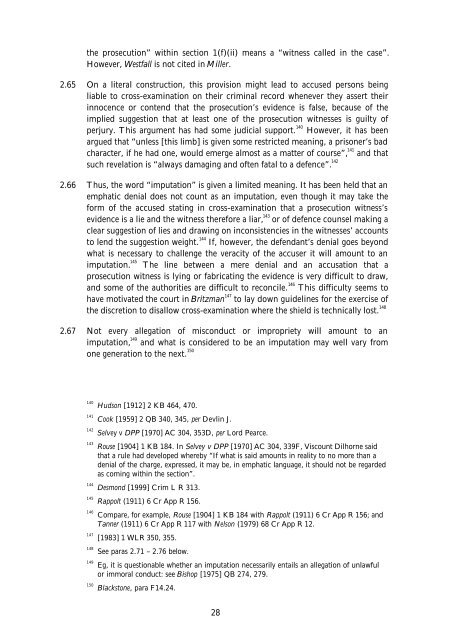Evidence of Bad Character in Criminal ... - Law Commission
Evidence of Bad Character in Criminal ... - Law Commission
Evidence of Bad Character in Criminal ... - Law Commission
You also want an ePaper? Increase the reach of your titles
YUMPU automatically turns print PDFs into web optimized ePapers that Google loves.
the prosecution” with<strong>in</strong> section 1(f)(ii) means a “witness called <strong>in</strong> the case”.<br />
However, Westfall is not cited <strong>in</strong> Miller.<br />
2.65 On a literal construction, this provision might lead to accused persons be<strong>in</strong>g<br />
liable to cross-exam<strong>in</strong>ation on their crim<strong>in</strong>al record whenever they assert their<br />
<strong>in</strong>nocence or contend that the prosecution’s evidence is false, because <strong>of</strong> the<br />
implied suggestion that at least one <strong>of</strong> the prosecution witnesses is guilty <strong>of</strong><br />
perjury. This argument has had some judicial support. 140 However, it has been<br />
argued that “unless [this limb] is given some restricted mean<strong>in</strong>g, a prisoner’s bad<br />
character, if he had one, would emerge almost as a matter <strong>of</strong> course”, 141 and that<br />
such revelation is “always damag<strong>in</strong>g and <strong>of</strong>ten fatal to a defence”. 142<br />
2.66 Thus, the word “imputation” is given a limited mean<strong>in</strong>g. It has been held that an<br />
emphatic denial does not count as an imputation, even though it may take the<br />
form <strong>of</strong> the accused stat<strong>in</strong>g <strong>in</strong> cross-exam<strong>in</strong>ation that a prosecution witness’s<br />
evidence is a lie and the witness therefore a liar, 143 or <strong>of</strong> defence counsel mak<strong>in</strong>g a<br />
clear suggestion <strong>of</strong> lies and draw<strong>in</strong>g on <strong>in</strong>consistencies <strong>in</strong> the witnesses’ accounts<br />
to lend the suggestion weight. 144 If, however, the defendant’s denial goes beyond<br />
what is necessary to challenge the veracity <strong>of</strong> the accuser it will amount to an<br />
imputation. 145 The l<strong>in</strong>e between a mere denial and an accusation that a<br />
prosecution witness is ly<strong>in</strong>g or fabricat<strong>in</strong>g the evidence is very difficult to draw,<br />
and some <strong>of</strong> the authorities are difficult to reconcile. 146 This difficulty seems to<br />
have motivated the court <strong>in</strong> Britzman 147 to lay down guidel<strong>in</strong>es for the exercise <strong>of</strong><br />
the discretion to disallow cross-exam<strong>in</strong>ation where the shield is technically lost. 148<br />
2.67 Not every allegation <strong>of</strong> misconduct or impropriety will amount to an<br />
imputation, 149 and what is considered to be an imputation may well vary from<br />
one generation to the next. 150<br />
140 Hudson [1912] 2 KB 464, 470.<br />
141 Cook [1959] 2 QB 340, 345, per Devl<strong>in</strong> J.<br />
142 Selvey v DPP [1970] AC 304, 353D, per Lord Pearce.<br />
143 Rouse [1904] 1 KB 184. In Selvey v DPP [1970] AC 304, 339F, Viscount Dilhorne said<br />
that a rule had developed whereby “If what is said amounts <strong>in</strong> reality to no more than a<br />
denial <strong>of</strong> the charge, expressed, it may be, <strong>in</strong> emphatic language, it should not be regarded<br />
as com<strong>in</strong>g with<strong>in</strong> the section”.<br />
144 Desmond [1999] Crim L R 313.<br />
145 Rappolt (1911) 6 Cr App R 156.<br />
146 Compare, for example, Rouse [1904] 1 KB 184 with Rappolt (1911) 6 Cr App R 156; and<br />
Tanner (1911) 6 Cr App R 117 with Nelson (1979) 68 Cr App R 12.<br />
147 [1983] 1 WLR 350, 355.<br />
148 See paras 2.71 – 2.76 below.<br />
149 Eg, it is questionable whether an imputation necessarily entails an allegation <strong>of</strong> unlawful<br />
or immoral conduct: see Bishop [1975] QB 274, 279.<br />
150 Blackstone, para F14.24.<br />
28

















